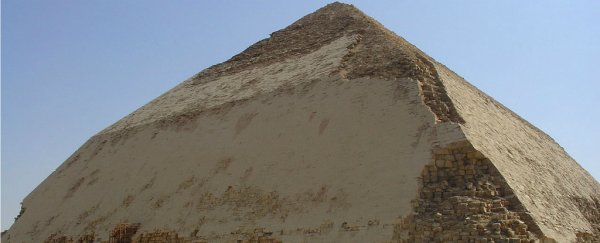An international team of researchers will soon begin analysing cosmic particle data collected from inside Egypt's Bent Pyramid, in the hopes of gaining insight into how the 4,600-year-old structure was built - including signs of any hidden passages or chambers.
For the past month, researchers have had highly sensitive detectors tucked away inside the pyramid, collecting data on invisible subatomic particles known as muons, which are constantly raining down on us from Earth's atmosphere.
Muons are created when cosmic rays from deep space interact with the atoms in Earth's atmosphere, and it's estimated that around 10,000 of them fall on a square metre of Earth per minute, travelling at nearly the speed of light. Like more powerful X-rays, these particles easily pass through empty space, but can be absorbed or deflected by dense materials, such as thick slabs of rock.
This means if researchers detect muons in one spot for long enough, they can use the data to create a picture of what the particles passed through above the detector. This technique is known as muon radiography and it's commonly used to map the inside structure of volcanoes.
"For the construction of the pyramids, there is no single theory that is 100 percent proven or checked. They are all theories and hypotheses," Hany Helal, vice president of the Heritage Innovation Preservation Institute in Egypt, told AP.
"What we are trying to do with the new technology, we would like to either confirm or change or upgrade or modify the hypotheses that we have on how the pyramids were constructed."
The Bent Pyramid is located around 40 km south of Cairo, and it's believed to have been built by Pharaoh Sneferu around 4,600 years ago. It's important because it's thought to be the Egyptian's first attempt at creating a smooth-sided pyramid, as opposed to the earlier steppe pyramids.
If the team is able to see from the cosmic particle detection that there are empty, or dense regions inside the pyramid, it will help Egyptologists to understand how the structure was formed, and what secrets it holds.
"Even if we find [a] 1-square-metre void somewhere, it will bring new questions and hypotheses and maybe it will help solve the definitive questions," said Mehdi Tayoubi, president of the Heritage Innovation Preservation Institute.
This isn't the first time scientists have used muons to map the inside of the pyramids. Back in the 1960s, a scientist called Luis Alvarez used a similar technique to unsuccessfully look for hidden chambers within Giza's Pyramid of Chephren.
But this new attempt, part of the ambitious Scan Pyramids project launched last year, uses detectors that are a whole lot more sensitive than those used by Alvarez, so it's hoped that the data collected will reveal more subtle details in the structure.
In November, the Scan Pyramids team announced that they'd found thermal anomalies in the 4,500-year-old Khufu Pyramid - the largest of the three Giza pyramids - suggesting that there may be a concealed chamber inside the structure. The team now plans to begin detecting muons inside Khufu in the coming months. We can't wait to see what they uncover.
